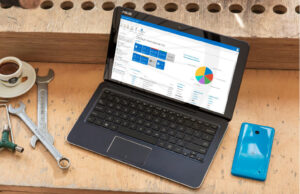Metal fabrication is an intensive, complicated, data-heavy, and highly precise business where manufacturers must meet strict demands, stick to rigid schedules, and ensure they are aligned with client expectations.
There’s a lot to consider, and that’s why many metal fabricators turn to enterprise resource planning (ERP) solutions to help them out.
What is Enterprise Resource Planning for Metal Fabrication?
An enterprise resource planning (ERP) system is an all-encompassing software program that assists manufacturers with various elements.
It works by integrating different tools and software solutions, all of which are built off the same foundation and provide a single source of data that aids with organization and efficiency and keeps every department and employee on the same page.
The market is awash with generic ERP solutions, but these are used by companies in various sectors, including healthcare, retail, human resources, and manufacturing. All companies need assistance with invoicing, inventory management, and customer relations, but how they approach each solution is vastly different, and “generic” simply isn’t good enough.
If your daily tasks include coil processing, multi-line processing, metal framing, and sheeting and leveling, why would you use software designed to manage healthcare facilities or major e-commerce operations?
Sure, you could make it work, but the whole point of ERP is that it works for you and not the other way around.
Metal fabrication ERP, therefore, is a solution tailored to meet the specific needs of those in the steel and metal fabrication industry.
At ReelSTEEL™, we have provided ERP solutions to numerous companies in the metal fabrication industry, and we’re confident that every single one of them has achieved far more benefits than they would if they had used a generic system.
Do You Need ERP Systems in the Steel Fabrication Industry?
Although ERPs are utilized in most industries, these systems and the manufacturing resource planning (MRP) systems that preceded them were made for the manufacturing industry.
If you’re involved with steel or metal fabrication and are looking for a way to simplify and enhance operations, you need an ERP solution. They are used across the industry by small, medium, and large manufacturers and provide a solid operational foundation.
ERP Modules for Metal Fabrication
The usefulness of the ERP system comes down to its modules, each one of which is designed to target a specific area or need and can be added to the software as required. The modules available for steel and metal fabrication ERP include:
CRM
Comprehensive customer relationship management (CRM) gives manufacturers a direct line to their customers, promoting loyalty and dealing with queries, requests, orders, customization, and refunds. Additional implementations can also track the effectiveness of marketing campaigns by monitoring leads and conversions.
CAD
Incorporate CAD designs that you or your customer creates before using these to generate accurate quotes. It will clearly define what materials are needed, and how these requirements change once the project is underway.
Inventory Management
Orders are sent, materials are purchased, and shipments are tracked. Once the materials arrive in the warehouse, this ERP module will ensure they are accounted for.
Detailed reports are then provided to show project managers what materials are available, if they have enough of them, and if they are in sufficient condition to continue.
Workload Schedule
Project plans are made based on available employees, materials, and equipment capacity. There are a lot of plates to keep in the air, but workload scheduling modules will simplify this process and allocate resources in a way that promotes productivity.
Equipment won’t be overloaded, and employees won’t be overrun—everything and everyone will be fully utilized.
Data Archiving
Data solutions are essential for metal fabrication businesses. There’s a lot of data to collect, organize, and secure, and as this data is governed by strict regulations, fabricators must endeavor to ensure that everything is safe and secure and that the privacy of all customers is maintained.
Material Resource Planning (MRP)
Waste is a big—and costly—problem in the metal manufacturing industry. Using MRP modules, manufacturers can assign only the materials that are needed to keep waste and costs low.
Sales Orders and Invoicing
Much time is wasted completing sales orders, chasing invoices, generating reports, and checking accounts. It doesn’t need to be that way. ERP uses machine learning to adapt to the company’s operations before AI automation takes the pain of menial financing tasks away.
What are the Benefits of ERP for Metal Fabrication?
The goal of adopting ERP systems is not simply to have the latest tech so you can gloat to clients and competitors. It’s not even about making life easier for yourself and your clients, although ERP can certainly do that.
The main goal is to increase sales and grow the business, and it does this by boosting efficiency and improving productivity.
Metal fabrication ERP offers a slew of benefits:
- Reduces lead time, keeping clients happy and wasting fewer resources on the production line.
- Makes it easier to meet client demands, particularly with regard to customized projects.
- Gets more use out of equipment and ensures everything is properly maintained and quickly updated.
- Removes redundant processes that merely serve to waste time and money.
- Provides quicker and more accurate quotes.
- Prevents under or overstocking by keeping detailed, real-time inventory updates.
- Minimizes disruptions in the supply chain by tracking each shipment and understanding where issues arise.
- Provides a single source of information that all departments can access.
- Creates traceability throughout the entire supply chain, helping the company to remain compliant while assisting with quality control.
Integrate a Customized Metal ERP System
RealSTEEL™ provides ERP systems tailored to metal fabrication, including steel fabrication, metal framing, and steel service centers. We can build and implement a customized solution that adapts to your business and is flexible enough to grow as you grow, with support for modules such as:
- Multi-line processing
- Sheeting and levelling
- Coil processing software
- Flat rolled software
- Metal fabrication software
- Steel optimization software
- Steel service center software
Contact us to request a demo and learn more about the solutions that we provide.




